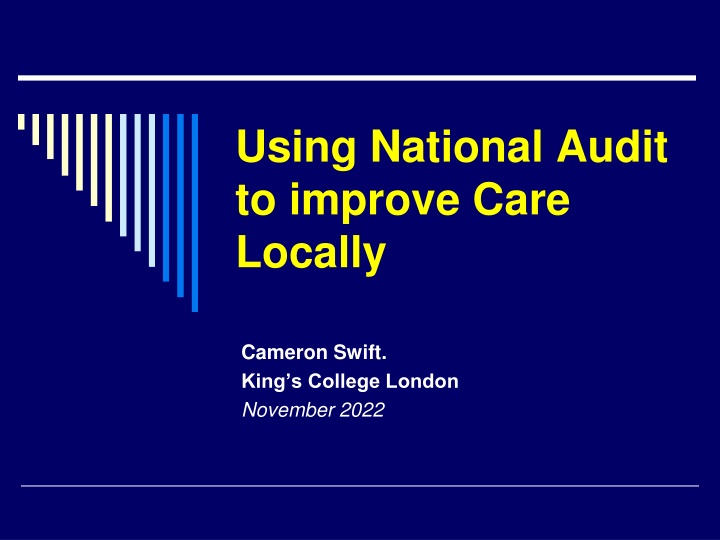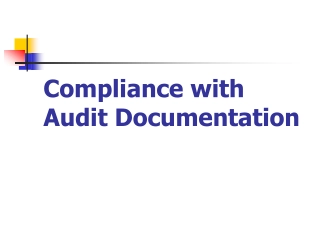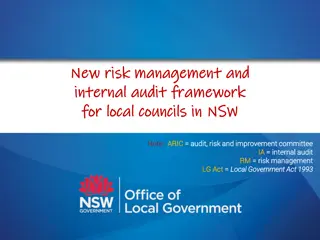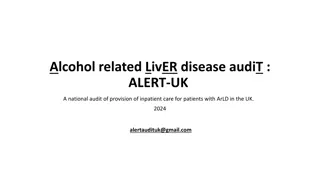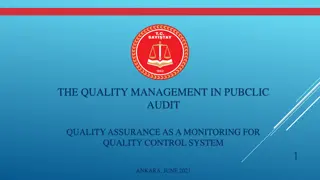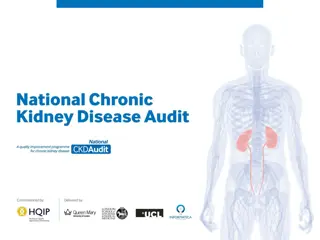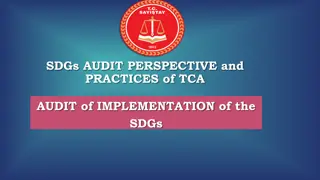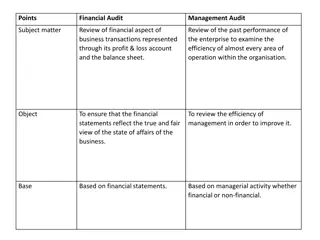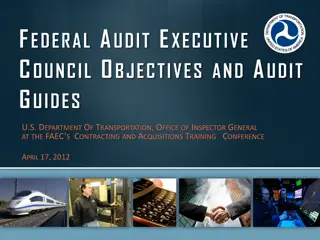Utilizing National Audit for Local Care Enhancement
This article discusses the significance of national audits in improving local care, focusing on fall prevention in later life and evidence-based resources such as NICE guidelines. It highlights the importance of quality standards, evidence for hip fracture care, and the model for hip fracture programs, emphasizing multidisciplinary approaches for better patient outcomes.
Download Presentation

Please find below an Image/Link to download the presentation.
The content on the website is provided AS IS for your information and personal use only. It may not be sold, licensed, or shared on other websites without obtaining consent from the author.If you encounter any issues during the download, it is possible that the publisher has removed the file from their server.
You are allowed to download the files provided on this website for personal or commercial use, subject to the condition that they are used lawfully. All files are the property of their respective owners.
The content on the website is provided AS IS for your information and personal use only. It may not be sold, licensed, or shared on other websites without obtaining consent from the author.
E N D
Presentation Transcript
Using National Audit to improve Care Locally Cameron Swift. King s College London November 2022
AN EXAMPLE OF NATIONAL IMPORTANCE: FALLS & FRAGILITY# IN LATER LIFE 30% >65: 50%>80 fall at least once yearly Injury, disability, dependency, mortality NHS annual cost > 2.3bn
Key evidence-based national audit resources (see also BOA/BGS Blue-book, SIGN etc) (Focus on: *Fragility Hip# *Falls Prevention in older people) NICE Guidelines (e.g. CG 124/161) NICE Quality Standards (e.g. QS 16/86 National Audit Databases RCP FFFAP (NHFD (+BPT) /FLSDB/ NAIF)
NICE Quality Standards Not fixed targets Measurable high level audit measures of local quality in structure, process or outcome Expressed as proportions not necessarily 100% norm Maximally evidence-based Where possible, set in the context of national data collection e.g. NAIF/ NHFD Selection periodically adjusted for perceived priority improvement need.
EVIDENCE: Hip Fracture_CG124 (2011 -14 -17-19) Measurable evidence-based Categories 1. Imaging options in occult hip fracture 2. Timing of surgery 3. Analgesia 4. Anaesthesia 5. Planning the theatre team 6. Surgical procedures (2017 / 2019 updates) 7. Mobilisation strategies 8. Multidisciplinary management (HFP) 9. Patient and carer information
EVIDENCE Hip Fracture Programme Model [CG124] Acute orthopaedic or orthogeriatric ward base Orthogeriatric assessment Rapid optimisation of fitness for surgery Early identification of individual goals for multidisciplinary rehabilitation to recover mobility and independence, and to facilitate return to pre-fracture residence and long-term wellbeing Continued, coordinated, orthogeriatric and multidisciplinary review Liaison or integration with related services, particularly mental health, falls prevention, bone health, primary care and social services Clinical and service governance responsibility for all stages of the pathway of care and rehabilitation, including those delivered in the community.
EVIDENCE:Management of hip fracture Accident & Emergency: Preliminary Assessment - Surgical, Anaesthetic, Medical, Nursing, Rehab goals Theatre Orthopaedic / Specialist Ward: Perioperative surgical, nursing and related management with referral as required Usual Care MDM: HFP MDR: SD MDR: GORU MDR: IC MDR: MARU MDR: SC FINAL DISCHARGE
EVIDENCE: Key model inputs and CEA findings COSTS FOR EACH STRATEGY: Rehab programme Complications Readmissions Health care costs after hospital discharge Social care costs (when living in own home or in residential or nursing home) HEALTH OUTCOMES FOR EACH STRATEGY EQ-5Ds scores for all health states* Life expectancy HEALTH STATES = QALYs HFP is the DOMINANT STRATEGY (more effective, less costly) than both GORU/MARU and usual care
NHFD Evidence-based KPIs 2019 & 2021 (COVID19) RCP NHFD 2022 2019 2021
Outcome:Seasonal variation in 30-day hip# mortality, 2011-2018 (NHFD 2019) (See also Griffin et al 2021: EQ-5D-5L)
Variation: KPI 2 Caterpillar Plot (Time to surg,) (NHFD 2021)
NHFD data use and local QI achievement: Waterlow assessment and hip# pressure sore incidence. [NHFD 2018]
Local implementation for progress across KPI s: [NHFD 2018] Examine own NHFD data in dashboards and run charts Investigate and address causes of poor performance Ensure full multidisciplinary clinical governance representation Achieve continuity of clinical governance, including post-discharge follow-up Identify local concerns/challenges and chart NHFD data prospectively to drive QI.
NHFD Development & Resources (NHFD 2022) From 2011 annual national & local services audit & BPT delivery Benchmarking tables; mortality data; realtime data run-charts; KPI caterpillar plots 2022 ahead website as quarterly reporting cycle and Governance Tool to further support local data analysis, implementation and QI progress
Current NHFD audit recommendations (RCP NHFD, 2022) Monthly clinical multidisciplinary and management governance meetings to monitor runtime data, address suboptimal performance and plan QI Quarterly MDM access to NHFD site & Governance Tool as further QI drivers [New additional KPI s re analgesia (KPI0) & bone health (KPI7)]
FALLS IN LATER LIFE: A SIGNAL AS WELL AS A THREAT Commonly detectable (Intrinsic / Extrinsic): Ageing processes (diminished physiological reserve) Suboptimal physical fitness Stable specific impairment (e.g. sensory, motor, visual, CNS) Unstable systemic illness (diagnosed or undiagnosed) Environmental risk factors 1. 2. 3. 4. 5.
EVIDENCE - POSITIVE: FALLS IN LATER LIFE PREVENTABLE (i) (Close et al, Lancet 1999) 600 510 500 400 Control Intervention 300 203 183 156 151 200 73 60 50 100 0 0-4mth 4-8mth 8-12mth Total
EVIDENCE - POSITIVE: FALLS IN LATER LIFE PREVENTABLE (ii) (LOGAN et al, BMJ 2010) (7.68 vs 3.46 control vs intervention)
EVIDENCE - POSITIVE: FALLS IN LATER LIFE PREVENTABLE (iii) (DAVISON et al, 2005) 688 700 617 600 500 387 400 300 200 131 102 94 68 65 100 0 Intervention (n=159) Control (n=154) Falls* Fallers (No) Fallers (%) Hospital Bed Days
NICE Guidance (CG161) (update pending - 2024) Case/risk identification Specialist multifactorial falls risk assessment & diagnosis Falls history Assessment of: gait, balance and mobility, and muscle weakness osteoporosis risk perceived functional ability and fear relating to falling visual impairment cognitive impairment and neurological examination urinary continence environmental hazards Cardiovascular examination and medication review Individualised multifactorial interventions
NATIONAL AUDIT NICE quality standard QS86 (2017 UPDATE STATEMENTS) 1 Older people are asked about falls when they have routine assessments and reviews with health and social care practitioners, and if they present at hospital. 2. Older people at risk of falling are offered a multifactorial falls risk assessment. 3. Older people assessed as being at increased risk of falling have an individualised multifactorial intervention. 4.Older people who fall during a hospital stay are checked for signs or symptoms of fracture and potential for spinal injury before they are moved. 5. Older people who fall during a hospital stay and have signs or symptoms of fracture or potential for spinal injury are moved using safe manual handling methods. 6. Older people who fall during a hospital stay have a medical examination. 7. Older people who present for medical attention because of a fall have a multifactorial falls risk assessment. 8. Older people living in the community who have a known history of recurrent falls are referred for strength and balance training. 9. Older people who are admitted to hospital after having a fall are offered a home hazard assessment and safety interventions.
EVIDENCE: FALLS IN INPATIENTS Heterogeneous studies and settings (e.g. acute. non-acute, mixed) Highest risk category Inconsistent or negative findings with single factor or non-tailored interventions Risk factor prediction tools insufficiently sensitive or specific Some moderate/low evidence for multifactorial assessment and intervention strategies More research needed
EVIDENCE - POSITIVE: Effect of targeted risk factor reduction programme on inpatient falls (per thousand occupied bed days)(Healey et al, 2004) 25 20 15 Pre Post 10 5 0 Control Intervention
EVIDENCE: NICE CG 161: COST-EFFECTIVENESS OF INPATIENT FALLS PREVENTION
Fallsafe care bundle key elements [RCP 2015] Bed-rail/Ultra- low bed strategy* Cognitive assessment* Delirium screen* Lying & standing blood pressure & pulse* Medical & medication review* Basic visual check* Tailored on- ward (v 2-hr) observation regimen
INPATIENT IMPLEMENTATION & OUTCOME MEASUREMENT Fallsafe QI evaluation [Healey et al 2014]
NATIONAL AUDIT SNAPSHOT KPI DATA - INPATIENT FALLS PREVENTION 2017 (v 2015) (RCP NAIF 2019)
PROCEDURE USE NEEDING FURTHER EVIDENCE (NAIF Facilities audit 2019) (RCP 2020)
NATIONAL AUDIT & QI: Inpatient falls per 1,000 bed days AT Northumbria Healthcare NHS Foundation Trust 2013 2020. (Richardson et al., 2020)
NATIONAL AUDIT OF INPATIENT FALLS (NAIF) 2018- 21 (RCP 2020) Focus on inpatient hip fracture (IHF). Rational sensitive audit outcome measure Continuous year-round national data collection (NHFD) Increased incentive for trust level participation Fall prevention management audited for IHF only All inpatient settings eligible to participate (inc. community, specialist, mental health trusts) Data collection to include immediate post fall management (QS 86) Data entered onto the NHFD as IHF Once yearly facilities audit
NHFD 6 KPIs FOR INPATIENT & NON-INPATIENT HIP FRACTURE [NHFD 2021]
NATIONAL AUDIT OF INPATIENT FALLS (NAIF) 2018-21 (RCP 2021) DATA regularly updated, openly accessible GUIDANCE e.g. Vision assessment Postural blood pressure measurement Post-fall management* Gaining insight (v. incident review only)* Hot debrief (immediate info collection) After action review (MDT learning) *In development
SOME BENEFITS OF NATIONAL AUDIT PARTICIPATION Validity and availability of engagement with national evidence based guidance. National peer comparison and resources as incentives. Acquisition of reliable national data as a driver for local progress Open, shared culture of serious risk recognition and prevention e.g. hip#. Focused, forward trust-level accountability
In Conclusion Based on the FFFAP record to date: Robust evidence is key to the sustainable real-world impact of all audit initiatives Evidence-based national audit has major potential to drive local (as well as national) improvement Configuration flexibility may be needed to ensure the pivotal required engagement Standardised local clinical and administrative governance are essential
